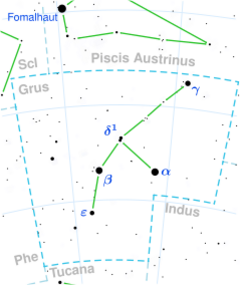Astronomy:Delta1 Gruis
| Observation data Equinox J2000.0]] (ICRS) | |
|---|---|
| Constellation | Grus |
| Right ascension | 22h 29m 16.17481s[1] |
| Declination | −43° 29′ 44.0245″[1] |
| Apparent magnitude (V) | 4.0 - 4.2[2] |
| Characteristics | |
| Spectral type | G6/8 III[3] |
| U−B color index | +0.81[4] |
| B−V color index | +1.03[4] |
| Variable type | SR[2] |
| Astrometry | |
| Radial velocity (Rv) | +4.9±0.8[5] km/s |
| Proper motion (μ) | RA: +25.72[1] mas/yr Dec.: −3.32[1] mas/yr |
| Parallax (π) | 10.54 ± 0.22[1] mas |
| Distance | 309 ± 6 ly (95 ± 2 pc) |
| Absolute magnitude (MV) | −1.1[6] |
| Details | |
| Mass | 4.0[6] M☉ |
| Radius | 24[6] R☉ |
| Luminosity | 305[6] L☉ |
| Surface gravity (log g) | 2.54±0.28[7] cgs |
| Temperature | 5,013±88[7] K |
| Metallicity [Fe/H] | −0.23±0.09[7] dex |
| Rotational velocity (v sin i) | 8.2[8] km/s |
| Other designations | |
| Database references | |
| SIMBAD | data |
Delta1 Gruis, Latinized from δ1 Gruis, is a candidate binary star[10] system in the constellation Grus. With a peak apparent visual magnitude of 4.0 it is bright enough to be seen with the naked eye at night. The distance to this system, as determined using an annual parallax shift of 10.54 mas as seen from the Earth,[1] is around 309 light years. It is gradually moving away from the Sun with a radial velocity of +4.9 km/s.[5]
The brighter component of this system is an evolved, yellow-hued, G-type giant star with a stellar classification of G6/8 III.[3] It is a semiregular variable that ranges between apparent magnitudes 3.99 and 4.2,[2] located 325 light-years from Earth. Delta1 Gruis has around 3 times the mass and 24 times the diameter of the Sun. The fainter companion is a magnitude 12.8 star at an angular separation of 5.6 arc seconds, as of 2008.[10]
See also
References
- ↑ 1.0 1.1 1.2 1.3 1.4 1.5 van Leeuwen, F. (2007), "Validation of the new Hipparcos reduction", Astronomy and Astrophysics 474 (2): 653–664, doi:10.1051/0004-6361:20078357, Bibcode: 2007A&A...474..653V.
- ↑ 2.0 2.1 2.2 Watson, Christopher (25 August 2009), "Delta 2 Gruis", AAVSO Website (American Association of Variable Star Observers), http://www.aavso.org/vsx/index.php?view=detail.top&oid=14810, retrieved 18 January 2014.
- ↑ 3.0 3.1 Houk, N. (1978), Michigan catalogue of two-dimensional spectral types for the HD stars, 2, Dept. of Astronomy, University of Michigan, Bibcode: 1978mcts.book.....H.
- ↑ 4.0 4.1 Johnson, H. L. et al. (1966), "UBVRIJKL photometry of the bright stars", Communications of the Lunar and Planetary Laboratory 4 (99): 99, Bibcode: 1966CoLPL...4...99J.
- ↑ 5.0 5.1 Gontcharov, G. A. (November 2006), "Pulkovo Compilation of Radial Velocities for 35495 Hipparcos stars in a common system", Astronomy Letters 32 (11): 759–771, doi:10.1134/S1063773706110065, Bibcode: 2006AstL...32..759G.
- ↑ 6.0 6.1 6.2 6.3 Ottoni, G.; Udry, S.; Ségransan, D.; Buldgen, G.; Lovis, C.; Eggenberger, P.; Pezzotti, C.; Adibekyan, V. et al. (January 2022), "CORALIE radial-velocity search for companions around evolved stars (CASCADES): I. Sample definition and first results: Three new planets orbiting giant stars", Astronomy & Astrophysics 657: A87, doi:10.1051/0004-6361/202040078, ISSN 0004-6361, Bibcode: 2022A&A...657A..87O.
- ↑ 7.0 7.1 7.2 Alves, S. et al. (April 2015), "Determination of the spectroscopic stellar parameters for 257 field giant stars", Monthly Notices of the Royal Astronomical Society 448 (3): 2749–2765, doi:10.1093/mnras/stv189, Bibcode: 2015MNRAS.448.2749A.
- ↑ De Medeiros, J. R.; Alves, S.; Udry, S.; Andersen, J.; Nordström, B.; Mayor, M. (January 2014), "A catalog of rotational and radial velocities for evolved stars: V. Southern stars⋆⋆⋆", Astronomy & Astrophysics 561: A126, doi:10.1051/0004-6361/201220762, ISSN 0004-6361, Bibcode: 2014A&A...561A.126D.
- ↑ "del01 Gru". SIMBAD. Centre de données astronomiques de Strasbourg. http://simbad.u-strasbg.fr/simbad/sim-basic?Ident=del01+Gru.
- ↑ 10.0 10.1 Eggleton, P. P.; Tokovinin, A. A. (September 2008), "A catalogue of multiplicity among bright stellar systems", Monthly Notices of the Royal Astronomical Society 389 (2): 869–879, doi:10.1111/j.1365-2966.2008.13596.x, Bibcode: 2008MNRAS.389..869E.
 |


